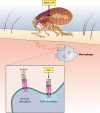Antivirulence genes: insights into pathogen evolution through gene loss - PubMed (original) (raw)
Review
Antivirulence genes: insights into pathogen evolution through gene loss
Kimberly A Bliven et al. Infect Immun. 2012 Dec.
Abstract
The emergence of new pathogens and the exploitation of novel pathogenic niches by bacteria typically require the horizontal transfer of virulence factors and subsequent adaptation--a "fine-tuning" process--for the successful incorporation of these factors into the microbe's genome. The function of newly acquired virulence factors may be hindered by the expression of genes already present in the bacterium. Occasionally, certain genes must be inactivated or deleted for full expression of the pathogen phenotype to occur. These genes are known as antivirulence genes (AVGs). Originally identified in Shigella, AVGs have improved our understanding of pathogen evolution and provided a novel approach to drug and vaccine development. In this review, we revisit the AVG definition and update the list of known AVGs, which now includes genes from pathogens such as Salmonella, Yersinia pestis, and the virulent Francisella tularensis subspecies. AVGs encompass a wide variety of different roles within the microbe, including genes involved in metabolism, biofilm synthesis, lipopolysaccharide modification, and host vasoconstriction. More recently, the use of one of these AVGs (lpxL) as a potential vaccine candidate highlights the practical application of studying AVG inactivation in microbial pathogens.
Figures
Fig 1
Inhibition of pathogenesis in Shigella. Pathogenesis phenotypes interrupted by Shigella AVGs. The product of the lysine decarboxylase reaction, cadaverine, inhibits ShET1/ShET2 enterotoxin activity (part 1), phagosome escape (part 4), and PMN transepithelial migration (part 6). Another small molecule, quinolinic acid, is the product of the nadA/nadB enzymatic reactions and inhibits both Shigella invasion (part 3) and intracellular spread (part 5). Inactivation of speG, which encodes the spermidine acetyltransferase, allows spermidine to accumulate within the phagosome and ultimately promotes bacterial survival in the macrophage (part 2). OmpT, an outer membrane protease, cleaves IcsA from the bacterial surface, preventing actin tail polymerization and inhibiting cell-to-cell spread (part 5).
Fig 2
Metabolic pathways lost in Shigella. Compounds or enzymes still present in Shigella are marked in black; those that have been lost are marked in red. (A) Lysine decarboxylation. (B) Biosynthetic and salvage NAD pathways. (C) Spermidine metabolism.
Fig 3
Inhibition of pathogenesis in Yersinia. nghA and rcsA encode proteins that inhibit biofilm formation in Yersinia: NghA directly degrades formed biofilm, and RcsA increases the repression ability of RcsB, an inhibitor of biofilm formation. Inactivation of these genes allows Yersinia to form a biofilm on the proventriculus of the flea, enabling bacterial transmission. LpxL mediates hexa-acetylation of lipid A on bacterial LPS, thus activating TLR4 and stimulating the host immune response to this pathogen. Loss of lpxL in all sequenced Y. pestis isolates leads to increased pathogen evasion of host innate immune defenses.
Similar articles
- Black holes, antivirulence genes, and gene inactivation in the evolution of bacterial pathogens.
Maurelli AT. Maurelli AT. FEMS Microbiol Lett. 2007 Feb;267(1):1-8. doi: 10.1111/j.1574-6968.2006.00526.x. FEMS Microbiol Lett. 2007. PMID: 17233672 Review. - Postgenomic analysis of bacterial pathogens repertoire reveals genome reduction rather than virulence factors.
Merhej V, Georgiades K, Raoult D. Merhej V, et al. Brief Funct Genomics. 2013 Jul;12(4):291-304. doi: 10.1093/bfgp/elt015. Epub 2013 Jun 29. Brief Funct Genomics. 2013. PMID: 23814139 - Microbial genome analysis: insights into virulence, host adaptation and evolution.
Wren BW. Wren BW. Nat Rev Genet. 2000 Oct;1(1):30-9. doi: 10.1038/35049551. Nat Rev Genet. 2000. PMID: 11262871 Review. - Antivirulence and avirulence genes in human pathogenic fungi.
Siscar-Lewin S, Hube B, Brunke S. Siscar-Lewin S, et al. Virulence. 2019 Dec;10(1):935-947. doi: 10.1080/21505594.2019.1688753. Virulence. 2019. PMID: 31711357 Free PMC article. Review.
Cited by
- The dynamics of evolutionary rescue from a novel pathogen threat in a host metapopulation.
Jiao J, Fefferman N. Jiao J, et al. Sci Rep. 2021 May 25;11(1):10932. doi: 10.1038/s41598-021-90407-z. Sci Rep. 2021. PMID: 34035424 Free PMC article. - The use of genome wide association methods to investigate pathogenicity, population structure and serovar in Haemophilus parasuis.
Howell KJ, Weinert LA, Chaudhuri RR, Luan SL, Peters SE, Corander J, Harris D, Angen Ø, Aragon V, Bensaid A, Williamson SM, Parkhill J, Langford PR, Rycroft AN, Wren BW, Holden MT, Tucker AW, Maskell DJ; BRADP1T Consortium. Howell KJ, et al. BMC Genomics. 2014 Dec 24;15:1179. doi: 10.1186/1471-2164-15-1179. BMC Genomics. 2014. PMID: 25539682 Free PMC article. - Integrated Metabolic Modeling, Culturing, and Transcriptomics Explain Enhanced Virulence of Vibrio cholerae during Coinfection with Enterotoxigenic Escherichia coli.
Abdel-Haleem AM, Ravikumar V, Ji B, Mineta K, Gao X, Nielsen J, Gojobori T, Mijakovic I. Abdel-Haleem AM, et al. mSystems. 2020 Sep 8;5(5):e00491-20. doi: 10.1128/mSystems.00491-20. mSystems. 2020. PMID: 32900868 Free PMC article. - A Secreted Chorismate Mutase from Xanthomonas arboricola pv. juglandis Attenuates Virulence and Walnut Blight Symptoms.
Assis RAB, Sagawa CHD, Zaini PA, Saxe HJ, Wilmarth PA, Phinney BS, Salemi M, Moreira LM, Dandekar AM. Assis RAB, et al. Int J Mol Sci. 2021 Sep 26;22(19):10374. doi: 10.3390/ijms221910374. Int J Mol Sci. 2021. PMID: 34638715 Free PMC article. - Genome Variation and Molecular Epidemiology of Salmonella enterica Serovar Typhimurium Pathovariants.
Branchu P, Bawn M, Kingsley RA. Branchu P, et al. Infect Immun. 2018 Jul 23;86(8):e00079-18. doi: 10.1128/IAI.00079-18. Print 2018 Aug. Infect Immun. 2018. PMID: 29784861 Free PMC article. Review.
References
- Awano S, et al. 1999. Sequencing, expression and biochemical characterization of the Porphyromonas gingivalis pepO gene encoding a protein homologous to human endothelin-converting enzyme. FEBS Lett. 460:139–144 - PubMed
Publication types
MeSH terms
LinkOut - more resources
Full Text Sources


